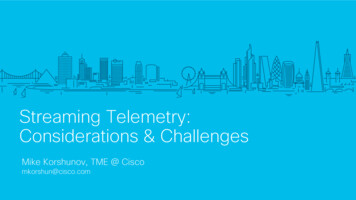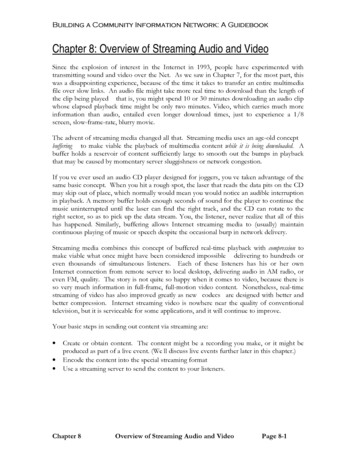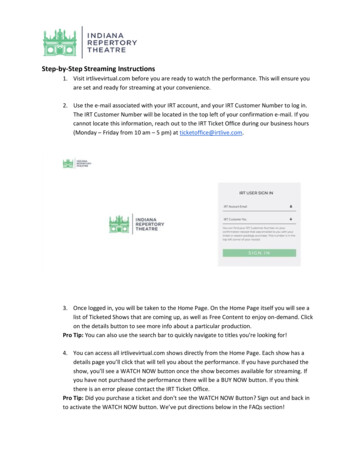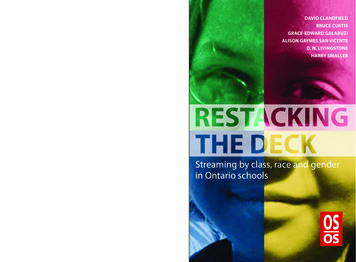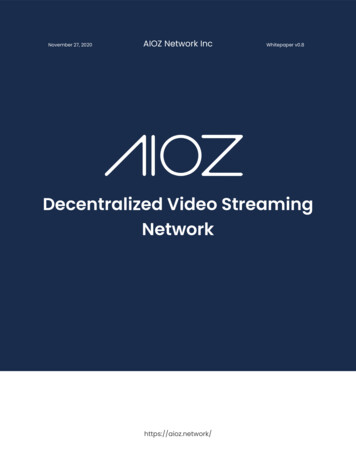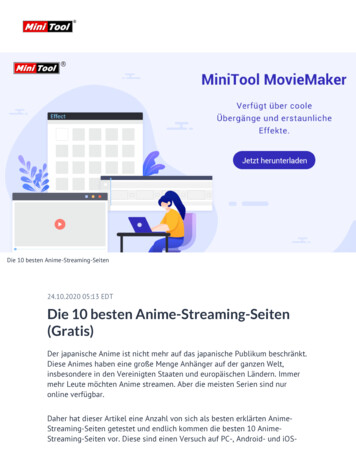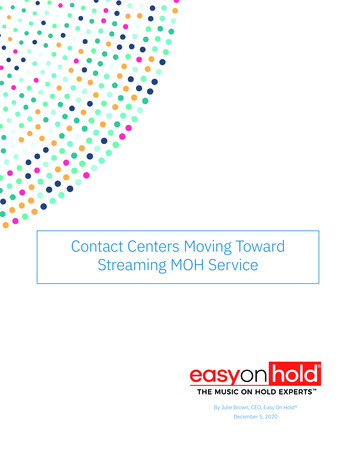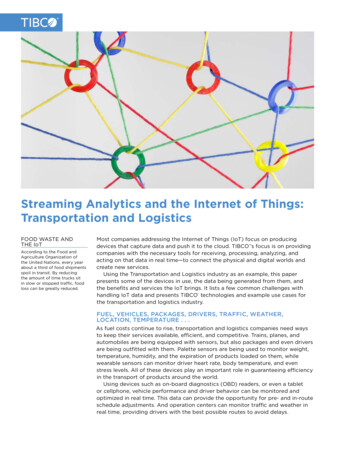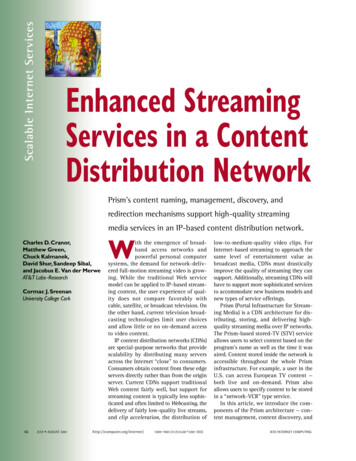
Transcription
Scalable Internet ServicesEnhanced StreamingServices in a ContentDistribution NetworkPrism’s content naming, management, discovery, andredirection mechanisms support high-quality streamingmedia services in an IP-based content distribution network.Charles D. Cranor,Matthew Green,Chuck Kalmanek,David Shur, Sandeep Sibal,and Jacobus E. Van der MerweAT&T Labs–ResearchCormac J. SreenanUniversity College Cork66JULY AUGUST 2001ith the emergence of broadband access networks andpowerful personal computersystems, the demand for network-delivered full-motion streaming video is growing. While the traditional Web servicemodel can be applied to IP-based streaming content, the user experience of quality does not compare favorably withcable, satellite, or broadcast television. Onthe other hand, current television broadcasting technologies limit user choicesand allow little or no on-demand accessto video content.IP content distribution networks (CDNs)are special-purpose networks that providescalability by distributing many serversacross the Internet “close” to consumers.Consumers obtain content from these edgeservers directly rather than from the originserver. Current CDNs support traditionalWeb content fairly well, but support forstreaming content is typically less sophisticated and often limited to Webcasting, thedelivery of fairly low-quality live streams,and clip acceleration, the distribution ofWhttp://computer.org/internet/1089 -7801/01/ 10.00 2001 IEEElow-to-medium-quality video clips. ForInternet-based streaming to approach thesame level of entertainment value asbroadcast media, CDNs must drasticallyimprove the quality of streaming they cansupport. Additionally, streaming CDNs willhave to support more sophisticated servicesto accommodate new business models andnew types of service offerings.Prism (Portal Infrastructure for Streaming Media) is a CDN architecture for distributing, storing, and delivering highquality streaming media over IP networks.The Prism-based stored-TV (STV) serviceallows users to select content based on theprogram’s name as well as the time it wasaired. Content stored inside the network isaccessible throughout the whole Prisminfrastructure. For example, a user in theU.S. can access European TV content —both live and on-demand. Prism alsoallows users to specify content to be storedin a “network-VCR” type service.In this article, we introduce the components of the Prism architecture — content management, content discovery, andIEEE INTERNET COMPUTING
Content ne networkAccess networkContent distribution: from live sourcesto portals and portal-to-portalContent delivery: from portals to clientsFigure 1. Prism data plane. Content distribution mechanisms transfer content from a live source to one or more portals;content delivery mechanisms pass content from a portal to one or more clients.content-aware redirection — and briefly describethe status of a trial Prism architecture as well asour future plans for the system. While we focus onapplying the Prism architecture to services involving live and stored television content, the framework and architectural components are applicableto other content-based streaming services such asvideo on demand.Prism Architectural ElementsThe Prism architecture comprises three basic elements. Live sources receive content from a content provider, encode and packetize it, and then streamit into the Prism IP network infrastructure.Portals receive multimedia content from livesources and other portals, and transmit it toPrism clients. Portals can store and archive livecontent, thus allowing it to be viewed ondemand, and provide VCR-like functions suchas fast-forward and rewind. Portals are positioned between clients and live sources, typically at or upstream of a bandwidth discontinuity such as a cable head end.Clients receive content from a portal and display it to end users. Clients are networked settop boxes or PCs connected to the backboneusing broadband access.These three elements, shown in Figure 1, communicate through the network on either the dataplane or the control plane. Because the data planeis not unique to Prism (all streaming CDNs requirethis functionality), we consider it only briefly.Figure 1 shows Prism’s data plane components. Content distribution mechanisms transfer con-IEEE INTERNET COMPUTING tent from a live source to one or more portals,or transfer content between portals.Content delivery mechanisms stream contentfrom a portal to one or more clients. Portalsshould be topologically close to clients in orderto provide acceptable perceived performancefor latency-sensitive operations such as VCRlike control functions.A unique aspect of Prism is that it stores live content inside the network for subsequent on-demandaccess. This differs from on-demand access in conventional CDNs in that there is no well-known origin server where content is known to reside.Prism’s control plane regulates the location andflow of content through the Prism infrastructure.Figure 2 (next page) shows the three main Prismcontrol plane components. The content manager coordinates content storage at portals. Input to the content management process includes information on type ofservice, service level agreements (SLAs) withcontent providers, portal capacity, and loadcaused by user access.Content discovery mechanisms determine theexistence and location of streaming contentwithin the Prism infrastructure. Note that whilecontent discovery is triggered by a user request,the actual discovery process, as shown in Figure 2, occurs between Prism entities and is notvisible to the user other than through the redirection process.Content-aware redirection mechanisms forwarduser requests to the portal that can best satisfy them. The location of the requested content,along with other input, can be used to deterhttp://computer.org/internet/JULY AUGUST 200167
Scalable Internet ServicesInputs:- Content location- Client location- Load- Client QoS- PolicyInputs:- Service type- SLA- Load- nRedirectorPortalPortalClientPortalAccess networkPortalBackbone networkContent managementContent discoveryContent-aware redirectionFigure 2. Prism control plane.The control plane regulates the location and flow of content through the Prism infrastructureusing content management, content discovery, and content-aware redirection mechanisms.name : “stv:” channel name “stv:” channel name “?” specificationchannel name: “ “ brand ”;“channel “;”distributor “;” location “ ”specification: “start ” utctime“start ” utctime “:end ” utctime“program ” name“program “ name ”;offset ” timeFigure 3. Naming scheme syntax.The channel name indicates aunique source of content.The specification indicates a time segmentcontent from a source.mine the appropriate portal from which content should be served to the customer. All edgeservers, including portals, have basic redirection capabilities. However, separate redirectionservers, or redirectors, typically perform thisspecialized control plane function.Another important architectural component iscontent naming. Before we address the controlplane components in more detail, we will describethe content naming scheme Prism uses to uniquely identify all or parts of a broadcast stream.form resource locator, or URL). Identifying contentby name allows users to access content in a varietyof ways without revealing Prism’s internal structure. Users can identify content according to a TVschedule or via content-aware search engines. Toproperly capture localized content from a cablesystem, the naming scheme must be able to specify which cable head end the content is sent over.Besides identifying content to a fine level of granularity where necessary, the naming schemeshould also be compatible with Web protocols.Prism content is generated by digitizing TV channels that are distributed and delivered in real-timeby unicast or multicast IP. Because content is accumulated and stored over time, it must be easy toreference by date and time (for example, “show meABC-TV aired on 30 June, from 9 a.m. to 10 a.m.”).Figure 3 shows the naming scheme syntax. Thecontent-naming URN consists of two parts: channel name and specification. The channel name consists of four elements, which collectively identify aunique source of content: Content NamingIn Prism, content is referenced by name (uniformresource name, or URN), rather than location (uni68JULY AUGUST 2001http://computer.org/internet/ The brand is the channel name users typicallyknow. It may be a simple identifier like “ABC” orthe brand’s fully qualified domain name.The channel is the call letters or channel number associated with the content. In some casesthis field might be null.The distributor indicates the entity responsibleIEEE INTERNET COMPUTING
Content DistributionTable 1. Examples of channel names. for distributing the contentsuch as the broadcast stationowner, a cable or satellitecompany, or an Internetbased content distributionsystem.The location is the source ofthe specified version of thecontent. This can be used toindicate a specific broadcasttower or cable head end.Channel nameMeaning (for listings)Meaning (for requests) abc;;; abc;wabc;; List available ABC stationsList available source for ABC stationWABC (broadcast, cable, satellite,and so on)List available Australian BroadcastingCo. sourcesList available ABC stations on DirectTVThe default ABC stationABC station WABC from thedefault source abc.net.au;;; abc;;directv; abc;wabc;comcast;orange nj Test for ABC station WABC onComcast’s Orange, N.J., systemThe channel name can be furtherqualified with start and end timesor a program name (the specification). Start and end times are expressed as Coordinated Universal Time (UTC) times (for example,“utc:20010215T2200”), as defined in the real-timestreaming protocol (RTSP).1 The program name withoptional time offset is a text string identifying content within a particular channel, and the time offsetis relative to the start of a program in seconds (suchas “program nypd blue” or “program nypd blue;offset 60”). A URN with no time offset implies thecurrent live version of that content.All of the channel name elements are optional.The meaning of unspecified elements in a channelname depends on the context in which the nameis used. If a channel listing query includes thechannel name, then unspecified elements matchall the available values in the system. Otherwise,unspecified values take the default values from theprofile of the user making the query. Table 1 listsexample channel names. Note that end users neednot understand or be aware of the channel-naming syntax, which can easily be hidden behind auser-friendly Web interface.Industry adoption of work being done within theInternet Engineering Task Force’s URN workinggroup will allow for the use of URN schemes likeours (see the sidebar, “Related Work on StreamingMedia,” page 74). In the absence of such a supportinfrastructure in the current Internet, we follow thecommon practice of encoding URNs within a URL.For example, stv: abc;wabc;; can be encodedin an RTSP URL as rtsp://server/prismurn/abc/wabc/*/*/.Content ManagementContent management in Prism coordinates contentdistribution and storage within the network infrastructure. This is done in a way that balances theresources required and those available against thetimely delivery of user-requested content. A conIEEE INTERNET COMPUTINGThe default source forAustralian Broadcasting Co.The default ABC station onDirectTVABC station WABC onComcast’s Orange, N.J., systemtent manager receives external input, for examplefrom an administrative interface or a configurationfile, as well as feedback from the portals it is managing (see Figure 4 on the next page).Unlike conventional video-on-demand solutionswhere content is fairly static, our STV serviceallows new content to be added continuously. Thecontent manager needs to tell the infrastructurewhich TV streams are of interest and which partsof those streams should be stored for how long.Figure 4 shows the two main types of messagesinvolved in Prism content management. (There isalso an options message that allows content managers and portals to discover capabilities and operation modes of portals.) A content manager sends update messages tothe portal regarding policies, resource usage,and content manipulation. The content manager tells portals what content to obtain when andwhich storage and eviction policies to bind tothat content. Update messages let the contentmanager tell the portal how its resources shouldbe partitioned and which entity is responsiblefor managing which partition. Portal storagespace is the main resource of concern, but otherresources could also be managed in this way.Report messages carry information from portals to a content manager. Messages can betriggered by a content manager request, a timerexpiring, or a threshold being reached. A portal uses this message (primarily at startup) toinform the content manager about its availableresources. Report messages also convey content usage statistics and load. The contentmanager uses this information in dynamiccontent management decisions. For example,if the set of portals that currently have a particular movie are becoming loaded withhttp://computer.org/internet/JULY AUGUST 200169
Scalable Internet ServicesInputs:- Service type- SLA- ortalPortalUpdate messageReport messageFigure 4. Content management in Prism. A content manager coordinates media storage on a set of distributed portals. Amaster content manager can delegate some of the portal resources to be controlled by another content manager. Contentmanagers also signal to peer content managers in other administrative domains. Binding Store rtsp://staging/customerY/firstclip.mov /Store Delete at-utc-time ”20011001T000001Z” rtsp://staging/customerY/firstclip.mov /Delete /Binding .Figure 5. An example update message.The message instructs theportal to download a file, store it, and evict it at a specified time.requests, a content manager could instructother portals to retrieve and store that movie.As indicated in Figure 4, multiple content managerscan manage the same portals. This is useful if different content managers are specialized for differentservices or content types. For example, one contentmanager could exclusively deal with a movie-ondemand service, while another could realize STV.Figure 4 also shows interaction between contentmanagers in different administrative domains, facilitating inter-CDN content management. For example, in a content brokering arrangement,2 a CDNmight want to push content to the peering CDNbefore redirecting requests for that content to it.The essence of content management exchangeis best conveyed through a few simple examples.We use XML to encode the information exchanged70JULY AUGUST 2001http://computer.org/internet/between content managers and portals. Figure 5shows an update message fragment indicating tothe portal that it should immediately download andstore the clip indicated by the RTSP URL, and deleteit at one second after midnight on 1 October 2001.Figure 6 shows part of a slightly more involvedupdate message (for lack of space, we do not showexample report messages). This message createspolicies on the portal, manages resource usage onthe portal as a whole, and manipulates content.The first part of the message tells the portal to create a named policy (my stv policy), which willevict any content bound to it after five hours. Thesecond part tells the portal that 50 percent of itsstorage resources will be managed by the specifiedcontent manager (cm.att.com), while the remaining 50 percent is available for local caching (indicated by the delegation of this space to the “local”content manager). Finally, the portal is instructedto store live content associated with the indicated“PBS” URL. This content will be stored continuously for five hours, at which time the oldest partwill be evicted.Content DiscoveryWhen a client requests content from Prism, theredirector first uses content discovery to determinethe content’s location. The redirector then typically sends the client to a portal that has the requested content. When portals that have the content areheavily utilized, the redirector can dynamicallyincrease the number of portals serving the content.In the latter case, the content’s actual locationIEEE INTERNET COMPUTING
Content Distribution. Policy Create my stv policy Type duration ”5h” DeleteOlderThan /Type /Create /Policy Associate Storage allocation ”50%”manager ”cm.att.com” / Storage allocation ”50%”manager ”local” / /Associate Binding Store rtsp://prism/prismurn/pbs/*/*/* /Store Delete eviction-policy ”my stv policy” rtsp://prism/prismurn/pbs/*/*/* /Delete /Binding .might be encoded in the redirection URL, or theportal might query the content discovery service.Prism decouples content discovery and contentmanagement functions. An alternative is an integrated approach, where the content managementsystem maintains all the information used for content discovery. This approach, however, has several limitations: First, it does not readily support local storagepolicies or decisions by portals (for example, toallow discovery of content cached by portals).Second, the same infrastructure can includedifferent content management solutions thatvary in their levels of sophistication or servicesupport. An integrated approach would requireportals to interface with several content management systems, rather than a single contentdiscovery system, to do content discovery.Prism’s content discovery architecture is built ona mapping service, which links content, identifiedby a URN, to a set of URLs. Each portal managesits own content according to content managementpolicies. The mapping service maintains contentmetadata, such as its type, encoding, and descriptive information, which can be used to limitresponses to queries.Uniform resource identifier mapping protocol.Portals use the Prism URI mapping protocol (UMP)to dynamically update content metadata stored inthe mapping service and to query the mapping service for content location. (Note that UMP mapsfrom URNs to URLs. In general, however, it mightmap between any type of URI and we therefore usethe more general term.) UMP reuses both the syntax and semantics of existing protocols, such asthe hypertext transfer protocol (HTTP)3 and thesession initiation protocol (SIP).4UMP is a request-response protocol, where anode receiving a request message always generates a response. UMP allows the issuance of concurrent requests to improve performance. EachUMP message carries a transaction identifier sothat the order of responses does not have to matchthe order of requests. When a node receives a UMPrequest, it can immediately generate a response orit can first forward the request to other nodes. Inthe latter case, the intermediate node collects theresponses from the other nodes, possibly filteringor aggregating them, and forwards one or moreresponses to the request originator. Thus, UMP isextremely flexible: it can be used in a simpleIEEE INTERNET COMPUTINGFigure 6. A complex update message.The message gives instructions for policy creation, resource usage, and file handling.client-server model, or it can be forwarded along amesh of nodes.There are currently three UMP request methods: An update message indicates that content identified by one or more FromURIs (or URNs) isstored at a particular ToURI (or URL).A query requests a mapping from a particularFromURI to one or more ToURIs.An options message requests parameters related to UMP operation (for example, centralizedversus distributed, multicast, or unicast).Figure 7 (next page) shows a sample U
The Prism-based stored-TV (STV) service allows users to select content based on the program’s name as well as the time it was aired. Content stored inside the network is accessible throughout the whole Prism infrastructure. For example, a user in the U.S. can access European TV conte
